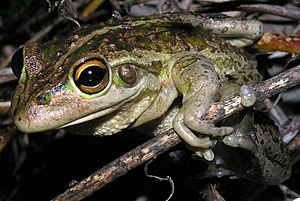Motorcycle frog
| Motorcycle frog | ||||||||||||
|---|---|---|---|---|---|---|---|---|---|---|---|---|

Motorcycle frog ( Ranoidea moorei ) |
||||||||||||
| Systematics | ||||||||||||
|
||||||||||||
| Scientific name | ||||||||||||
| Ranoidea moorei | ||||||||||||
| ( Copland , 1957) |
The motorcycle frog ( Ranoidea moorei , synonym : Litoria moorei ), also known as the western golden tree frog or Moore'scher frog , is a ground-dwelling frog from southwestern Australia . The motorcycle frog got its name from its mating call, which is very similar to the switching process of a motorcycle transmission. Ranoidea moorei belongs to the Ranoidea aurea complex , which also includes Ranoidea aurea , Ranoidea raniformis , Ranoidea dahlii and Ranoidea cyclorhynchus .
features
Motorcycle frogs are very adept at disguising themselves in their surroundings ( mimetic ); The decisive factor here is their skin pigmentation, which ranges in color from dark brown to green to gold. The ventral side is lighter and has a mostly pale green to light brown grain.
As is common with tree frogs, the motorcycle frog has small suction cups on its toes that are useful when climbing difficult vertical surfaces. The animal also has powerful hind limbs and webbed toes. During the mating season, the males develop oestrus calluses , with which the female is held during mating.
The tadpoles of the species have a dark brown body with a silver sheen underneath. Initially rather small, they grow very quickly to a size of around 80 mm. The tadpoles instinctively hide in the vegetation, but come out quickly when food comes within reach. Most of the time at this stage of development they spend in groups to better protect themselves.
Spread and endangerment
The animal can be found in large parts of southwest Australia, such as in Port Gregory, north of Geraldton , towards Albany and the surrounding area and inland to the Western Australian Wheat Belt . It is also found in the Perth area , preferably in coastal, flat habitats. The motorcycle frog is particularly popular there, as it is the most common frog to be found in the house gardens.
Lakes, swamps, garden ponds and reservoirs are among the frogs' favorite territories, where they can often be found on plant stalks or other elevated places where they bathe in the sun. Without water, they can still live for a long time if necessary.
Unlike many of its relatives in the Ranoidea aurea complex, Ranoidea moorei is far less at risk of becoming an endangered species. Because the frog has a relatively wide distribution area, has a high tolerance to changing environmental conditions, is numerous in individuals and shows no or very little tendency to decline, it is assumed that the endangered species status should not turn negative anytime soon. While the species and related species are affected by chytrid fungal infections, this is not really a cause for concern.
Reproduction and way of life
The mating season for the motorcycle frog begins at the beginning of spring until late summer. During this time, the well-known mating call made by the males can often be heard. To do this, they look for a suitable position on reeds or other aquatic plants. Mating takes place when a female ready to mate approaches the male so that the male can cling to her with the help of his oestrus calluses. The spawn , in the form of sticky, transparent lumps, is attached to floating debris and vegetation, where it lingers until the young hatch.
Although the motorcycle frog is an Australian tree frog, it very rarely climbs higher than a meter or two into the foliage, it is ground-related and stays at this altitude for most of its time.
Motorcycle frogs mainly eat arthropods , but rarely other small frogs; even cannibalism against juveniles can happen. In the tadpole stage, the diet consists of algae and occasionally meat. The tadpoles, like adults, expose themselves to the blazing sun for one to two hours a day in order to encourage their growth.
literature
- Harold G. Cogger: Reptiles & Amphibians of Australia. 2nd, revised edition. AH & AW Reed Pty Ltd, London 1979, ISBN 978-0-5890-7176-9 .
- MJ Tyler: Australian Frogs - A Natural History. Reed Books, 1994, ISBN 0-7301-0468-0 .

